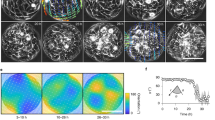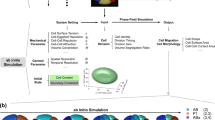Abstract
Living organisms form a large variety of hierarchically structured extracellular functional tissues. Remarkably, these materials exhibit regularity and structural coherence across multiple length scales, far beyond the size of a single cell. Here, synchrotron-based nanotomographic imaging in combination with machine-learning-based segmentation is used to reveal the structural synchronization process of nacre forming in the shell of the mollusc Unio pictorum. We show that the emergence of this highly regular layered structure is driven by a disorder-to-order transition achieved through the motion and interaction of screw-like structural dislocations with an opposite topological sign. Using an analogy to similar processes observed in liquid-crystalline systems, we demonstrate that these microstructural faults act as dissipative topological defects coupled by an elastic distortion field surrounding their cores. Their mutual annihilation results in structural synchronization that is simulated using the classical Kuramoto model. The developed experimental, theoretical and numerical framework provides a comprehensive physical view of the formation of biogenic materials.
This is a preview of subscription content, access via your institution
Access options
Access Nature and 54 other Nature Portfolio journals
Get Nature+, our best-value online-access subscription
$29.99 / 30 days
cancel any time
Subscribe to this journal
Receive 12 print issues and online access
$209.00 per year
only $17.42 per issue
Buy this article
- Purchase on Springer Link
- Instant access to full article PDF
Prices may be subject to local taxes which are calculated during checkout




Similar content being viewed by others
Data availability
The data that support the plots within this paper and other findings of this study are available from the corresponding author upon reasonable request.
Code availability
Code for the Kuramoto simulation is publicly available at https://github.com/Maxim-A-Beliaev/kuramoto-sim.
References
Fratzl, P. & Weinkamer, R. Nature’s hierarchical materials. Prog. Mater. Sci. 52, 1263–1334 (2007).
Bøggild, O. B. The shell structure of the mollusks. Kongel. Danske Vidensk. Selsk. Skr.: Naturvidensk. Math. Afd. 9, 231–326 (1930).
Carter, J. G. & Clark, G. R. Classification and phylogenetic significance of molluscan shell microstructure. Notes Short Course: Stud. Geol. 13, 50–71 (1985).
Lowenstam, H. A. & Weiner, S. On Biomineralization (Oxford Univ. Press, 1989).
Currey, J. D. & Taylor, J. D. The mechanical behaviour of some molluscan hard tissues. J. Zool. 173, 395–406 (1974).
Barthelat, F., Yin, Z. & Buehler, M. J. Structure and mechanics of interfaces in biological materials. Nat. Rev. Mater. 1, 16007 (2016).
Zlotnikov, I. & Schoeppler, V. Thermodynamic aspects of molluscan shell ultrastructural morphogenesis. Adv. Funct. Mater. 27, 1700506 (2017).
Schoeppler, V. et al. Biomineralization as a paradigm of directional solidification: a physical model for molluscan shell ultrastructural morphogenesis. Adv. Mater. 30, 1803855 (2018).
Cartwright, J. H. E. & Checa, A. G. The dynamics of nacre self-assembly. J. R. Soc. Interface 4, 491–504 (2007).
Dauphin, Y., Luquet, G., Salome, M., Bellot-Gurlet, L. & Cuif, J. P. Structure and composition of Unio pictorum shell: arguments for the diversity of the nacroprismatic arrangement in molluscs. J. Microsc. 270, 156–169 (2018).
Wegst, U. G. K., Bai, H., Saiz, E., Tomsia, A. P. & Ritchie, R. O. Bioinspired structural materials. Nat. Mater. 14, 23–36 (2015).
Ritchie, R. O. The conflicts between strength and toughness. Nat. Mater. 10, 817–822 (2011).
Barthelat, F. Nacre from mollusk shells: a model for high-performance structural materials. Bioinspir. Biomim. 5, 035001 (2010).
Checa, A. G. Physical and biological determinants of the fabrication of molluscan shell microstructures. Front. Mar. Sci. 5, 1–21 (2018).
Checa, A. G., Macías-Sánchez, E. & Ramírez-Rico, J. Biological strategy for the fabrication of highly ordered aragonite helices: the microstructure of the cavolinioidean gastropods. Sci. Rep. 6, 25989 (2016).
Willinger, M. G., Checa, A. G., Bonarski, J. T., Faryna, M. & Berent, K. Biogenic crystallographically continuous aragonite helices: the microstructure of the planktonic gastropod Cuvierina. Adv. Funct. Mater. 26, 553–561 (2016).
Currey, J. D. Bones: Structure and Mechanics (Princeton Univ. Press, 2013).
Fabritius, H. et al. in Chitin (ed. Gupta, N. S.) 35–60 (Springer, 2011).
Schoeppler, V. et al. Crystal growth kinetics as an architectural constraint on the evolution of molluscan shells. Proc. Natl Acad. Sci. USA 116, 20388–20397 (2019).
Gilbert, P. U. P. A. et al. Gradual ordering in red abalone nacre. J. Am. Chem. Soc. 130, 17519–17527 (2008).
Hovden, R. et al. Nanoscale assembly processes revealed in the nacroprismatic transition zone of Pinna nobilis mollusc shells. Nat. Commun. 6, 10097 (2015).
Wada, K. Spiral growth of nacre. Nature 211, 1427 (1966).
Yao, N., Epstein, A. K., Liu, W. W., Sauer, F. & Yang, N. Organic–inorganic interfaces and spiral growth in nacre. J. R. Soc. Interface 6, 367–376 (2009).
Gao, Y., Guo, Z., Song, Z. & Yao, H. Spiral interface: a reinforcing mechanism for laminated composite materials learned from nature. J. Mech. Phys. Solids 109, 252–263 (2017).
Cartwright, J. H. E., Checa, A. G., Escribano, B. & Sainz-Díaz, C. I. Spiral and target patterns in bivalve nacre manifest a natural excitable medium from layer growth of a biological liquid crystal. Proc. Natl Acad. Sci. USA 106, 10499–10504 (2009).
Wise, S. W. Jr & deVilliers, J. Scanning electron microscopy of molluscan shell ultrastructures: screw dislocations in pelecypod nacre. Trans. Am. Microsc. Soc. 90, 376–380 (1971).
Qi, L., Huang, Y., Zhou, Z. & Zhou, Z. The growth of the screw dislocation of nacreous layer on Pteria penguin. Sci. China Earth Sci. 54, 951–958 (2011).
Wang, X., Miller, D. S., Bukusoglu, E., de Pablo, J. J. & Abbott, N. L. Topological defects in liquid crystals as templates for molecular self-assembly. Nat. Mater. 15, 106–112 (2016).
Darmon, A., Benzaquen, M., Čopar, S., Dauchot, O. & Lopez-Leon, T. Topological defects in cholesteric liquid crystal shells. Soft Matter 12, 9280–9288 (2016).
Mesaros, A. et al. Topological defects coupling smectic modulations to intra-unit-cell nematicity in cuprates. Science 333, 426–430 (2011).
Pacureanu, A., Langer, M., Boller, E., Tafforeau, P. & Peyrin, F. Nanoscale imaging of the bone cell network with synchrotron X‐ray tomography: optimization of acquisition setup. Med. Phys. 39, 2229–2238 (2012).
Beliaev, M. et al. Quantification of sheet nacre morphogenesis using X-ray nanotomography and deep learning. J. Struct. Biol. 209, 107432 (2019).
Shen, Y. & Dierking, I. Annihilation dynamics of topological defects induced by microparticles in nematic liquid crystals. Soft Matter 15, 8749–8757 (2019).
Bogi, A., Martinot-Lagarde, P., Dozov, I. & Nobili, M. Anchoring screening of defects interaction in a nematic liquid crystal. Phys. Rev. Lett. 89, 225501 (2002).
Dierking, I. et al. Anisotropy in the annihilation dynamics of umbilic defects in nematic liquid crystals. Phys. Rev. E 85, 021703 (2012).
Rahman, A. Correlations in the motion of atoms in liquid argon. Phys. Rev. 136, A405–A411 (1964).
Peach, M. & Koehler, J. S. The forces exerted on dislocations and the stress fields produced by them. Phys. Rev. 80, 436–439 (1950).
Nudelman, F. Nacre biomineralisation: a review on the mechanisms of crystal nucleation. Semin. Cell Dev. Biol. 46, 2–10 (2015).
Mahler, S. et al. Dynamics of dissipative topological defects in coupled phase oscillators. J. Phys. B 52, 205401 (2019).
Kuramoto, Y. in International Symposium on Mathematical Problems in Theoretical Physics Vol. 39 (ed. Araki, H.) 420–422 (Springer, 1975).
Kuramoto, Y. Chemical Oscillations, Waves, and Turbulence (Springer, 1983).
Pargellis, A. N. et al. Defect dynamics and coarsening dynamics in smectic-C films. Phys. Rev. A 46, 7765–7776 (1992).
Bouligand, Y. in Liquid Crystalline Order in Polymers (ed. Blumstein, A.) Ch. 8 (Academic Press, 1978).
Bouligand, Y. in Liquid Crystals (ed. Liebert, L.) 259–294 (Academic Press, 1978).
Hubert, M. et al. Efficient correction of wavefront inhomogeneities in X-ray holographic nanotomography by random sample displacement. Appl. Phys. Lett. 112, 203704 (2018).
Acknowledgements
I.Z. acknowledges financial support provided by Bundesministerium für Bildung und Forschung through grant 03Z22EN11. We acknowledge the ESRF for providing beam time on ID16A for proposals SC4155 and IHLS2846. Finally, we thank L. Bertinetti (B CUBE, Technische Universität Dresden) for critically assessing the manuscript.
Author information
Authors and Affiliations
Contributions
M.B. and I.Z. designed the study. M.B. and D.Z. performed data analysis. A.P., P.Z. and I.Z. performed the X-ray experiments. M.B. and I.Z. wrote the manuscript, with input from all authors.
Corresponding author
Ethics declarations
Competing interests
The authors declare no competing interests.
Additional information
Peer review information Nature Physics thanks Julyan Cartwright and the other, anonymous, reviewer(s) for their contribution to the peer review of this work.
Publisher’s note Springer Nature remains neutral with regard to jurisdictional claims in published maps and institutional affiliations.
Supplementary information
Supplementary Video 1
Motion and annihilation of a dislocation pair. Each frame represents a 2D slice through the tomography data perpendicular to the direction of growth. Time in the video represents the growth of the nacreous ultrastructure. White and black represent the organic and mineral components, respectively. The right-handed and left-handed defects are marked in blue and red, respectively.
Supplementary Video 2
Simulated evolution of topography at the front of the growing structure, obtained using the Kuramoto model. Time in the video represents the growth of the structure.
Supplementary Video 3
Simulated evolution of the phase field at the front of the growing structure, obtained using the Kuramoto model. Time in the video represents the growth of the structure.
Supplementary Video 4
Simulated evolution of the elastic energy field at the front of the growing structure, obtained using the Kuramoto model. Time in the video represents the growth of the structure.
Rights and permissions
About this article
Cite this article
Beliaev, M., Zöllner, D., Pacureanu, A. et al. Dynamics of topological defects and structural synchronization in a forming periodic tissue. Nat. Phys. 17, 410–415 (2021). https://doi.org/10.1038/s41567-020-01069-z
Received:
Accepted:
Published:
Issue Date:
DOI: https://doi.org/10.1038/s41567-020-01069-z
This article is cited by
-
Functional control of oscillator networks
Nature Communications (2022)
-
The mother of all techniques
Nature Physics (2021)



